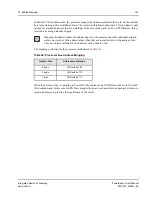
11. Signals and Pinout
194
PowerSpan II User Manual
80A1010_MA001_09
Integrated Device Technology
www.idt.com
PB_DBG[1]_
Tristate bidirectional
Hi-Z
Pull-up resistor
Data Bus Grant:
This is an input
when an external arbiter is used
and an output when the internal
arbiter is used. As input it is used
by an external arbiter to grant the
processor data bus to PowerSpan
II. As output it is used by the
internal arbiter to grant the
processor data bus to an external
bus master. This pin must be
weakly pulled high.
PB_DBG[2:3]_
Tristate output
Hi-Z
Pull-up resistor
Data Bus Grant:
This is an
output only. It is used by the
internal arbiter to grant the
processor data bus to external
bus masters. These pins must be
weakly pulled high.
PB_DP[0:7]
Tristate bidirectional
Hi-Z
No requirement
Data Parity:
The processor data
bus slave drives on reads, master
drives on write to indicate the
parity of the data bus.
PB_DVAL_
Tristate bidirectional
Hi-Z
Pull-up resistor
Data Valid:
Indicates if the data
beat is valid on PB_D[0:63].
PB_D[0:63]
Tristate bidirectional
Hi-Z
No requirement
Data Bus
PB_FAST
Input
-
Power-up option
PLL Configuration:
If the signal
is pulled low, it configures the PB
Interface PLL to operate with
input frequencies between 25 and
50 MHz. If the signal is pulled
high, it configures the PB
Interface PLL to operate with
input frequencies above 50 MHz
to a maximum of 100 MHz.
PB_GBL_
Tristate output
Hi-Z
Pull-up resistor
Global:
Indicates that the transfer
is coherent and it should be
snooped by bus masters.
PB_RSTCONF_
Input
(Schmitt trigger)
-
-
Reset Configuration:
Asserted
by PowerQUICC II master to
indicate to PowerSpan II to load
power-up options. This pin must
be pulled high if the multiplexed
system pin mechanism is used to
load the power-up options.
Table 55: Processor Bus Signals
Pin Name
Pin Type
Reset State
Recommended
Termination
Description
















































